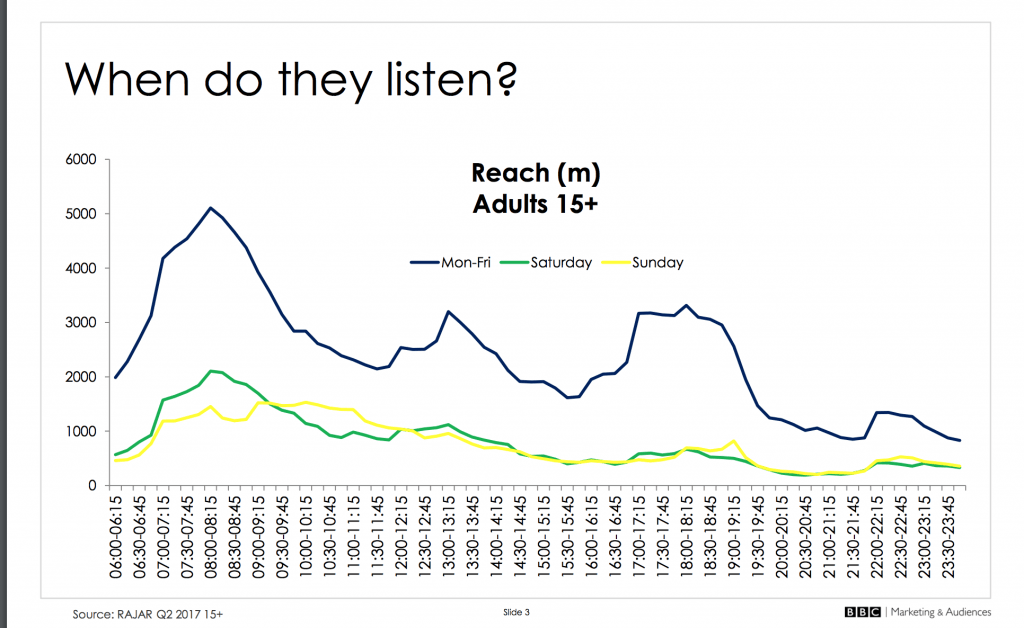We intend to pitch our programme to BBC Radio 4, meaning that we need to have a deep understanding of who the Radio 4 audience and what they want from their content, this in turn means that we would be much more successful in getting our programme commisioned for BBC Radio 4.
Within Radio 4’s remit published in 2016 it does not state a clearly defined audience demographic e.g 40-50 unlike that of BBC Radio 1 with an audience of 15-29 year-olds stated within its service remit (BBC,2016), whereas Radio 4’s service remit states. ”The service should appeal to listeners seeking intelligent programmes in many genres which inform, educate and entertain. ” (BBC,2016). What this in effect means is that from the offset programmes do not have to target a specific age group, but instead they have to target a more stylised approach, with our programme being comedy this means that we would most likely be pitching the programme via the entertainment commitment of Radio 4.
In terms of radio 4’s listening figures, in the most recent RAJAR ( Radio Joint Audience Research) survery at the time of writing (June) BBC Radio 4, was stated as having a reach of 11,551,000 people with this being 21% of the population, this was combined with a strong amount of time listened per head of 11 hours (Rajar,2017). This compared to the Rajar results of May stated that it had a lower reach of 11,113,000 people, but a higher amount of listening hours per listener with 11.5 (Rajar, 2017). This means that Radio 4’s audience is growing, meaning that we would potentially have more people that listen to the programme as a whole due to this increased growth, however it is a very modest increase in growth, meaning it’s impact will be marginal.
Alongside this BBC Radio 4 has also published its own internal audience data for anyone who wishes to pitch programmes so that they can understand the station’s demographics, focusing more on the times that people listen and what people listen to. The document states that ”News attracts the largest number of listeners at 10.34m per week, while factual reaches 9.41m. Drama attracts 6.96 million average listeners a week, and comedy reaches 5.52 million.” (BBC, 2017). This in effect means that our total audience would be within those 5.52 million people rather than say the 11,551,000 due to the figures.
The internal data also states the times that listeners listen to radio 4, which shows us that the comedy programmes between 18:30 -19:00 (refer to the section on commissioning here) do well and attract the largest audience of any comedy programme through the day, meaning that we would ideally place our programme here if we were allowed. However, due to the scheduling of Radio 4 this would never happen as we would be interrupting the archers and this would never be allowed. This means it would be far more likely for us to air our programme at a weekend due to their a being a less time-constrained schedule. (BBC, 2017)
-19:00 (refer to the section on commissioning here) do well and attract the largest audience of any comedy programme through the day, meaning that we would ideally place our programme here if we were allowed. However, due to the scheduling of Radio 4 this would never happen as we would be interrupting the archers and this would never be allowed. This means it would be far more likely for us to air our programme at a weekend due to their a being a less time-constrained schedule. (BBC, 2017)
http://downloads.bbc.co.uk/bbctrust/assets/files/pdf/regulatory_framework/service_licences/radio/2016/radio1_dec16.pdf
http://downloads.bbc.co.uk/bbctrust/assets/files/pdf/regulatory_framework/service_licences/radio/2016/radio4_apr16.pdf
http://www.rajar.co.uk/listening/quarterly_listening.php